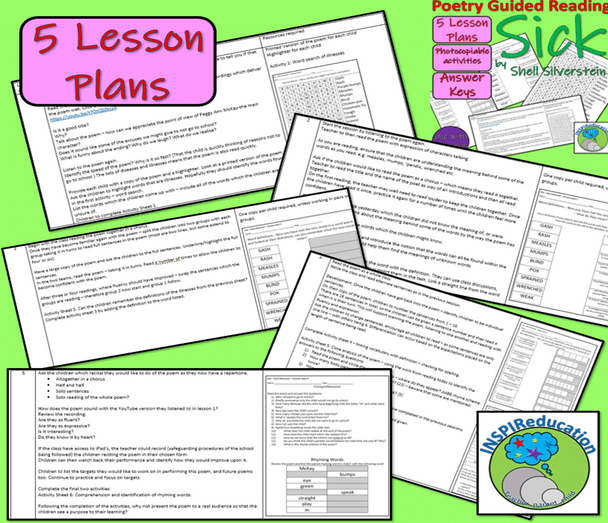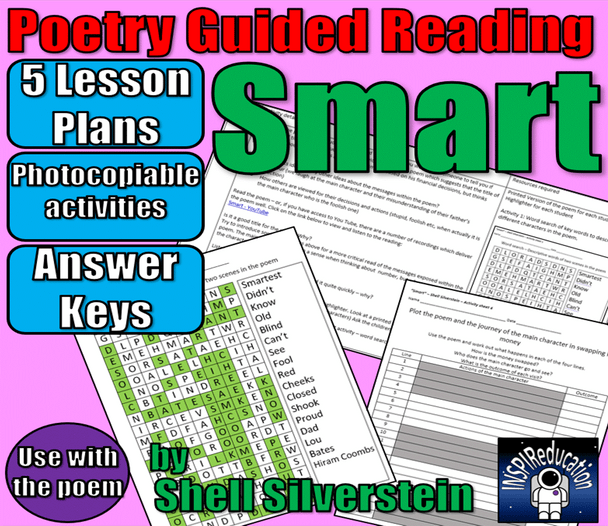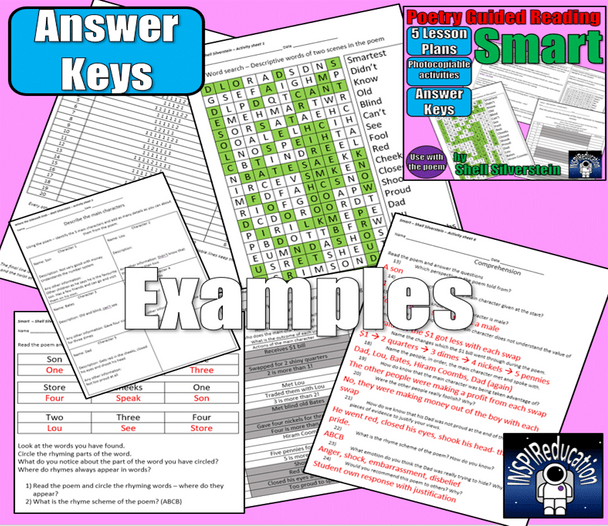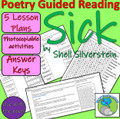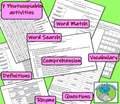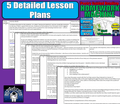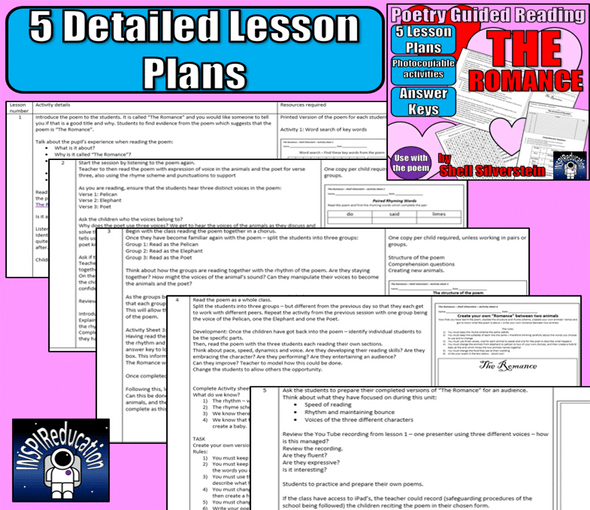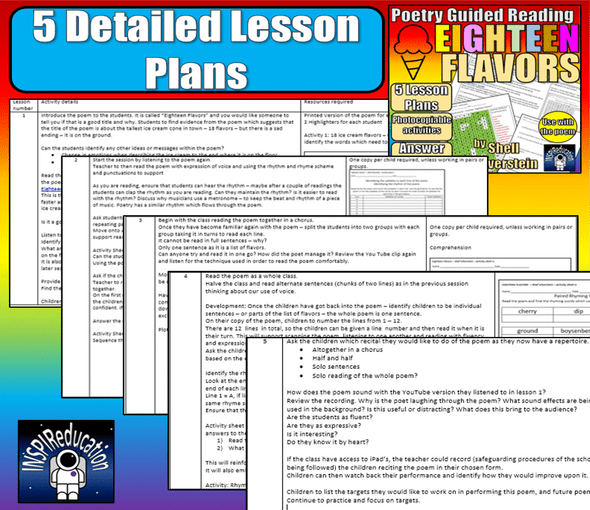Description
This bundle brings together our popular Poetry Guided Reading Lesson Plans linked to the poet Shell Silverstein. Each product takes one week (5 lessons) to deliver to students in 4th, 5th and 6th Grade and teaches the following skills:
- Imagery within specific poems
- Rhyme, Rhythm and structure of the poems
- Inference and deduction
- Humor in poetry
- Ability to read in a chorus, paired or independently
- Links to the poet reading their own work, and investigating how poetry recital can be improved
Each product contains the following resources:
- 5 daily, detailed lesson plans (including teaching points, what to look out for, what questions to ask and the answers to gain in order to interrogate the poems fully with students)
- 6 photocopiable resources
- Answer Key for all photocopiable resources
We are continuing to add to this growing bundle, but included currently are the following poems:
- Sick
- Homework Machine
- Smart
- Where the Sidewalk Ends
- Eighteen Flavors
- ATIONS
- Mr Grumpledump's Song
- The Romance
For more details on each poetry pack - see below:
Sick
This product has been developed as part of a week long Guided Reading Unit using the poem:
"Sick" by Shel Silverstein
In the poem, a child is desperate to not attend school and lists a whole host of reasons why she cannot go - all linked to being sick! The twist at the end makes the poem humorous and the children really love the entire piece.
We have put together our 5 detailed lesson plans which include notes on how to introduce the poem using a You Tube clip - the link is included in the teaching plans, before reading it yourself. The children therefore hear a professional recital of the poem and understand how fluency, pace and expression should be used.
Included in this product:
- 5 day, detailed lesson plan identifying how to teach the reading of the poem and links with specific resources included and when/how to use them.
- 6 photocopiable resources for the class to use
- Answer Key for each activity
Over the five lessons, the development of the reading of the poem is clear:
Day 1: Hear the poem for the first time, read it aloud together, trying to keep together
Day 2: Continue to practice the poem, adding in expression for how the character is discussing their illnesses - this also develops language knowledge too.
Day 3: Develop a chorus and split the group into two separate roles
Day 4: Group chorus to be developed further and individual children reading sections and finally, the whole poem with fluency and expression
Day 5: Work through the repertoire which the children now have - group performance, solo and group chorus. Day 5 also includes opportunities for assessment and target setting to reflect on next steps in learning.
Each day, not only do the children learn how to read, recite and perform poetry through a range of activities, but they get to know the poem in greater depth by completing 6 activities:
- Activity 1: Word search identifying new vocabulary
- Activity 2: Linking new vocabulary to its definition
- Activity 3: Give the definition to the new vocabulary
- Activity 4: Having been given the definition, spell correctly the new vocabulary
- Activity 5: Poetry observation - questions about the poem
- Activity 6: Comprehension questions and focus on the rhyme scheme
Each activity has its' own answer key, and can form part of the lesson, as it dictated in the lesson plan, or can be provided as a home based activity, early morning activity, early finisher, or Literacy Center activity.
Homework Machine
This product has been developed as part of a week long Guided Reading Unit using the poem:
"Homework Machine" by Shel Silverstein (not included in the resource but readily available)
In the poem, the poet describes the incredible invention of a homework machine, describes how it works, how much it costs and how easy it is to use - only to find at the end that it gives the wrong answer to 9 + 4!
We have put together our 5 detailed lesson plans which include notes on how to introduce the poem using a You Tube clip - the link is included in the teaching plans, before reading it yourself. The children therefore hear a professional recital of the poem and understand how fluency, pace and expression should be used.
Included in this product:
- 5 day, detailed lesson plan identifying how to teach the reading of the poem and links with specific resources included and when/how to use them.
- 6 photocopiable resources for the class to use
- Answer Key for each activity where it is needed (one activity is student response to imagery where they share how they respond to specific vocabulary within the poem, therefore no answer key is provided for this activity.
Over the five lessons, the development of the reading of the poem is clear:
Day 1: Hear the poem for the first time, read it aloud together, trying to keep together
Day 2: Continue to practice the poem, adding in expression for the different, contrasting main verses of childhood play and adult responsibility - this also develops language knowledge too.
Day 3: Develop a chorus and split the group into two separate roles
Day 4: Group chorus to be developed further and individual children reading sections and finally, the whole poem with fluency and expression
Day 5: Work through the repertoire which the children now have - group performance, solo and group chorus. Day 5 also includes opportunities for assessment and target setting to reflect on next steps in learning.
Each day, not only do the children learn how to read, recite and perform poetry through a range of activities, but they get to know the poem in greater depth by completing 6 activities:
- Activity 1: Word search identifying new vocabulary - descriptions and names of the 5 characters within the poem
- Activity 2: Rhythm of the poem, counting syllables, looking for patterns
- Activity 3: How the Homework Machine works - writing step-by-step instructions based on the information given within the lines of the poem
- Activity 4: Plotting the poem - how the information about the machine is given to the reader and how we become disappointed in the fact it does not work
- Activity 5: Rhyme Scheme, Poetry observation - questions about the poem
- Activity 6: Comprehension questions and review of learning and discussions through the five lessons
Each activity has its' own answer key, and can form part of the lesson, as it is dictated in the lesson plan, or can be provided as a home based activity, early morning activity, early finisher, or Literacy Center activity.
Smart
This product has been developed as part of a week long Guided Reading Unit using the poem:
"Smart" by Shel Silverstein (not included in the resource but readily available)
In the poem, the poet describes the journey of a "favourite son" given $1 by his Dad and then begins swapping the dollar for amounts he believes to be more and making a massive profit - in fact, the denominations become smaller and smaller - ending with a great response from the boy's Dad!
We have put together our 5 detailed lesson plans which include notes on how to introduce the poem using a You Tube clip - the link is included in the teaching plans, before reading it yourself. The children therefore hear a professional recital of the poem and understand how fluency, pace and expression should be used.
Included in this product:
- 5 day, detailed lesson plan identifying how to teach the reading of the poem and links with specific resources included and when/how to use them.
- 6 photocopiable resources for the class to use
- Answer Key for each activity where it is needed (one activity is student response to imagery where they share how they respond to specific vocabulary within the poem, therefore no answer key is provided for this activity.
Over the five lessons, the development of the reading of the poem is clear:
Day 1: Hear the poem for the first time, read it aloud together, trying to keep together
Day 2: Continue to practice the poem, adding in expression for the different, contrasting main verses of childhood play and adult responsibility - this also develops language knowledge too.
Day 3: Develop a chorus and split the group into two separate roles
Day 4: Group chorus to be developed further and individual children reading sections and finally, the whole poem with fluency and expression
Day 5: Work through the repertoire which the children now have - group performance, solo and group chorus. Day 5 also includes opportunities for assessment and target setting to reflect on next steps in learning.
Each day, not only do the children learn how to read, recite and perform poetry through a range of activities, but they get to know the poem in greater depth by completing 6 activities:
- Activity 1: Word search identifying new vocabulary - descriptions and names of the 5 characters within the poem
- Activity 2: Rhythm of the poem, counting syllables, looking for patterns
- Activity 3: Describing the main characters and inferring what we know about them
- Activity 4: Plotting the poem - the journey of the son and the changes made to the $1
- Activity 5: Rhyme Scheme, Poetry observation - questions about the poem
- Activity 6: Comprehension questions and review of learning and discussions through the five lessons
Each activity has its' own answer key, and can form part of the lesson, as it dictated in the lesson plan, or can be provided as a home based activity, early morning activity, early finisher, or Literacy Center activity.
Where the Sidewalk Ends
This product has been developed as part of a week long Guided Reading Unit using the poem:
"Where the Sidewalk Ends" by Shel Silverstein (not included in the resource but readily available)
In the poem, the poet describes a secret play-place which only children can find. It enables them to escape the smog and smoke of the city and play with excitement in an incredible place! It contrasts the life of adulthood with childhood - and implores children as they grow up to always find the time to play and balance their lives - a fantastic message for students today!
We have put together our 5 detailed lesson plans which include notes on how to introduce the poem using a You Tube clip - the link is included in the teaching plans, before reading it yourself. The children therefore hear a professional recital of the poem and understand how fluency, pace and expression should be used.
Included in this product:
- 5 day, detailed lesson plan identifying how to teach the reading of the poem and links with specific resources included and when/how to use them.
- 6 photocopiable resources for the class to use
- Answer Key for each activity where it is needed (one activity is student response to imagery where they share how they respond to specific vocabulary within the poem, therefore no answer key is provided for this activity.
Over the five lessons, the development of the reading of the poem is clear:
Day 1: Hear the poem for the first time, read it aloud together, trying to keep together
Day 2: Continue to practice the poem, adding in expression for the different, contrasting main verses of childhood play and adult responsibility - this also develops language knowledge too.
Day 3: Develop a chorus and split the group into two separate roles
Day 4: Group chorus to be developed further and individual children reading sections and finally, the whole poem with fluency and expression.
Day 5: Work through the repertoire which the children now have - group performance, solo and group chorus. Day 5 also includes opportunities for assessment and target setting to reflect on next steps in learning.
Each day, not only do the children learn how to read, recite and perform poetry through a range of activities, but they get to know the poem in greater depth by completing 6 activities:
- Activity 1: Word search identifying new vocabulary - contrasting styles used within the poem
- Activity 2: Linking new vocabulary to its definition
- Activity 3: Positive and negative used of vocabulary
- Activity 4: Exploring imagery within language
- Activity 5: Rhyme Scheme, Poetry observation - questions about the poem
- Activity 6: Comprehension questions and review of learning and discussions through the five lessons
Each activity has its' own answer key, and can form part of the lesson, as it dictated in the lesson plan, or can be provided as a home based activity, early morning activity, early finisher, or Literacy Center activity.
Eighteen Flavors
This product has been developed as part of a week long Guided Reading Unit using the poem:
"Eighteen Flavors" by Shel Silverstein (not included in the resource but readily available)
In the poem, the poet describes the best and tallest ice-cream cone in town with 18 amazing flavors, only to find at the end of the poem that it has fallen to the floor and will not be enjoyed by the owner!
We have put together our 5 detailed lesson plans which include notes on how to introduce the poem using a You Tube clip - the link is included in the teaching plans, before reading it yourself. The children therefore hear a professional recital of the poem and understand how fluency, pace and expression should be used.
Included in this product:
- 5 day, detailed lesson plan identifying how to teach the reading of the poem and links with specific resources included and when/how to use them.
- 5 photocopiable resources for the class to use
- Answer Key for each activity where it is needed (one activity is student response to imagery where they share how they respond to specific vocabulary within the poem, therefore no answer key is provided for this activity.
Over the five lessons, the development of the reading of the poem is clear:
Day 1: Hear the poem for the first time, read it aloud together, trying to keep together
Day 2: Continue to practice the poem, adding in expression for the different, contrasting main verses of childhood play and adult responsibility - this also develops language knowledge too.
Day 3: Develop a chorus and split the group into two separate roles
Day 4: Group chorus to be developed further and individual children reading sections and finally, the whole poem with fluency and expression
Day 5: Work through the repertoire which the children now have - group performance, solo and group chorus. Day 5 also includes opportunities for assessment and target setting to reflect on next steps in learning.
Each day, not only do the children learn how to read, recite and perform poetry through a range of activities, but they get to know the poem in greater depth by completing 6 activities:
- Activity 1: Word search identifying the 18 flavors of the ice cream - of which the students must identify from the poem, list them and then find in the word search.
- Activity 2: Rhythm of the poem, counting syllables, looking for patterns
- Activity 3: Sequencing the ice-cream cone, by drawing and labelling their own cone.
- Activity 4: Comprehension questions, inference and deduction skills
- Activity 5: Rhyme Scheme, Poetry observation - questions about the poem
Each activity has its' own answer key, and can form part of the lesson, as it dictated in the lesson plan, or can be provided as a home based activity, early morning activity, early finisher, or Literacy Center activity.
ATIONS
This product has been developed as part of a week long Guided Reading Unit using the poem:
"ATIONS" by Shel Silverstein (not included in the resource but readily available)
In the poem, the poet describes a meeting between two people - him and another (the person reading the poem) and through each of the lines, a different "ation" word is described and performed. This provides a great spring board for teaching the "ation" spelling pattern, words within the pattern and their meanings, but also, the interrogate the poem for how humans communicate through a sequence of actions.
We have put together our 5 detailed lesson plans which include notes on how to introduce the poem using a You Tube clip with Shell Silverstein reading his poem - the link is included in the teaching plans, before reading it yourself. The students therefore hear a professional recital of the poem and understand how fluency, pace and expression should be used.
Included in this product:
- 5 day, detailed lesson plan identifying how to teach the reading of the poem and links with specific resources included and when/how to use them.
- 5 photocopiable resources for the class to use
- Answer Key for each activity where it is needed (one activity is student response to imagery where they share how they respond to specific vocabulary within the poem, therefore no answer key is provided for this activity).
Over the five lessons, the development of the reading of the poem is clear:
Day 1: Hear the poem for the first time, read it aloud together, trying to keep together
Day 2: Continue to practice the poem, adding in expression for the different, contrasting main verses of childhood play and adult responsibility - this also develops language knowledge too.
Day 3: Develop a chorus and split the group into two separate roles
Day 4: Group chorus to be developed further and paired students reading the poem through a call and response structure - provided by the poem.
Day 5: Work through the repertoire which the students now have - group performance, paired and group chorus. Day 5 also includes opportunities for assessment and target setting to reflect on next steps in learning.
Each day, not only do the students learn how to read, recite and perform poetry through a range of activities, but they get to know the poem in greater depth by completing 6 activities:
- Activity 1: Word search identifying new vocabulary - contrasting styles used within the poem
- Activity 2: Cross word - learning the meaning of the "ation" vocabulary words in the poem
- Activity 3: Vocabulary links within the poem
- Activity 4: Rhythm of the poem using syllables and looking for patterns
- Activity 5: Drama/Mime performance and comprehension activities to further support the devleopment of the poem within the classroom.
Each activity has its' own answer key, and can form part of the lesson, as it dictated in the lesson plan, or can be provided as a home based activity, early morning activity, early finisher, or Literacy Center activity.
The Romance
This product has been developed as part of a week long Guided Reading Unit using the poem:
"The Romance" by Shel Silverstein (not included in the resource but readily available)
In the poem, the poet describes how two animals decide to get married as their names do not rhyme with any other animal - in the end, having got married, the Pelican and Elephant have a baby Pelicant - proving a happy ending for all.
We have put together our 5 detailed lesson plans which include notes on how to introduce the poem using a You Tube clip of the poem - the link is included in the teaching plans, before reading it yourself. The students therefore hear a professional recital of the poem and understand how fluency, pace and expression should be used.
Included in this product:
- 5 day, detailed lesson plan identifying how to teach the reading of the poem and links with specific resources included and when/how to use them.
- 4 photocopiable resources for the class to use
- Answer Key for each activity where it is needed (one activity is student response to imagery where they share how they respond to specific vocabulary within the poem, therefore no answer key is provided for this activity).
Over the five lessons, the development of the reading of the poem is clear:
Day 1: Hear the poem for the first time, read it aloud together, trying to keep together
Day 2: Continue to practice the poem, adding in expression for the different voices of the two animals and poet within the poem
Day 3: Develop a chorus and split the group into the three roles of elephant, pelican and poet
Day 4: Group chorus to be developed further and individual students try to read the poem individually using three distinct voices for the main characters
Day 5: Having written their own version of The Romance, to practice, refine and read their own poem to the class.
Each day, not only do the students learn how to read, recite and perform poetry through a range of activities, but they get to know the poem in greater depth by completing 4 activities:
- Activity 1: Word search of key vocabulary included in the poem
- Activity 2: Rhyming words, rhyme scheme and comprehension questions
- Activity 3: Rhythm of the lines using syllables, making new animal names, comprehension
- Activity 4: Create your own "Romance" poem, putting all the skills learnt during the sessions.
Each activity has its' own answer key, and can form part of the lesson, as it dictated in the lesson plan, or can be provided as a home based activity, early morning activity, early finisher, or Literacy Center activity.
Best wishes
INSPIReducation



